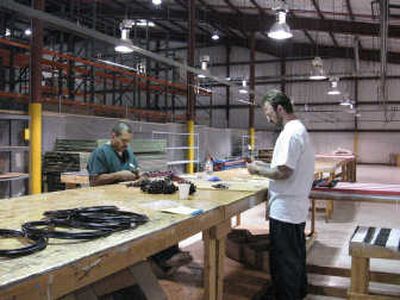Prison warehouse may house inmates

BOISE – Desperate for places to put its ever-increasing numbers of prisoners, Idaho is looking into converting a giant metal warehouse into prison beds for 304 inmates.
The 42,000-square-foot warehouse is at the Idaho Correctional Center, a hulking, concrete fortress of a prison south of Boise. But the warehouse, which encloses an entire acre and was built to house prison job programs, is just a standard metal building.
When the prison was built in 1998, the warehouse cost just $15 a square foot to construct, compared with an average of $140 a square foot in the rest of the prison. At the time, officials said it didn’t need the same security measures as the main prison, as inmates there would always be guarded because they’d have access to tools and equipment.
ICC Warden Phil Valdez acknowledges that the warehouse is less secure than the main prison, but said if an inmate were to escape from the structure, “you’re still within the fence.” An electronic “stun fence” encloses the entire ICC grounds.
Idaho Corrections Director Brent Reinke said, “It really comes down to the perimeter security, and from a perimeter standpoint that’s a very secure structure. … It is just a metal building, there is no question about that. But it is very containable.”
Gov. Butch Otter’s spokesman, Jon Hanian, said, “From our standpoint, we’ve got a crisis situation, and it’s not getting any better. We’ve got to do something to address it immediately. … We are looking at an emergency.”
Converting the warehouse into prison space, likely dormitory-style housing plus classrooms and programming space, is estimated to cost $6.5 million. Hanian said Otter hopes to tap into a special $15 million emergency fund that lawmakers set aside last year for the first $2.5 million, then ask next year’s Legislature to approve a supplemental appropriation to cover the rest of the cost. Otter is hoping to use much of the rest of the emergency fund for water projects.
“This is admittedly a stop-gap solution,” Hanian said.
Last year, lawmakers rejected a request from Otter to spend $1.8 million for a temporary building called a “Sprung Structure” to house 100 state prison inmates. Though Reinke said other states have used the membrane-covered structures for inmate housing, lawmakers worried that it wouldn’t be secure enough – especially after some learned that a determined inmate could push a sharpened pencil right through the membrane that forms the structure’s outer wall.
In the past, Idaho has resorted to housing inmates in tents seasonally at the minimum-security Southern Idaho Correctional Institution. Reinke said the warehouse conversion is a step to help avoid that.
Only minimum-security inmates who are nearing their release dates would be housed in the structure, he said, and they’d be kept busy from early morning until late in the evening with required programs, from drug treatment to counseling.
“These are minimum-custody inmates that we are working with to prepare them for release,” Reinke said. “It’s very comparable to those we are sending out of state.”
More than 500 Idaho inmates are past their first possible parole dates, and officials hope that providing more programs will help speed release for some, freeing up additional prison beds for others. Idaho has 550 inmates stashed in out-of-state private prisons, and hundreds more are expected to be shipped out of state before the end of the year.
The warehouse was built to house a “prison industry enterprise” program, where private employers would set up operations and employ inmates at prevailing wages. “But it has been very unsuccessful,” Reinke said.
“It’s really been a struggle to try to get that space occupied by the vendors.”
As a result, only a small portion of the warehouse is now being used for a job program. There, 10 to 15 inmate employees of Meridian-based Kimco Corp. assemble wiring parts.
Valdez said the warehouse at one time housed companies employing 150 inmates, but it never hit the goal of 20 percent of the ICC’s inmate population, or 262 inmates.
“We couldn’t get employers in place,” he said. That means Corrections Corporation of America, the lockup’s operator, is out of compliance with a contract provision and has been paying the state about $1 million a year in fines.
A new housing wing at ICC, identical to the current concrete cellblocks, has been approved for construction in 2008. It will house roughly 250 inmates.
CCA built and operates ICC, but the facility is owned by the state and takes only Idaho inmates. The contract to operate the prison is up for re-bid in 2009.